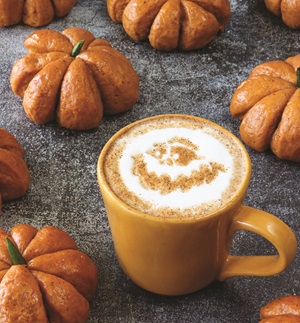(MyKeeneNow) – As the first crisp breeze of autumn sweeps in and leaves begin to turn shades of amber and gold, one flavor dominates the seasonal palate: pumpkin spice. For many, the arrival of pumpkin spice signals the official start of fall, a time when cozy sweaters, warm drinks, and festive traditions become the center of attention. B
A Brief History of Pumpkin Spice
Pumpkin spice, despite its modern-day association with lattes and baked goods, has roots that date back to early American history. The use of spices such as cinnamon, nutmeg, cloves, and ginger—key components of pumpkin spice—was common in colonial cooking, especially in the creation of pies and preserves. These spices were often blended with pumpkin, a native North American squash that was readily available to settlers, to create the iconic pumpkin pie.
However, “pumpkin spice” as we know it today wasn’t officially coined until the late 20th century. In 1934, McCormick, a prominent spice company, began selling a pre-blended “pumpkin pie spice,” designed to simplify the process of seasoning pies. Over the decades, this blend evolved into the modern version we see today: a combination of warm, aromatic spices that evoke the essence of autumn. Yet, it wasn’t until 2003 that pumpkin spice truly cemented itself in pop culture, when Starbucks introduced the Pumpkin Spice Latte (or PSL) to their seasonal menu. This drink became an instant sensation and sparked a craze that extended far beyond coffee shops.
What’s in Pumpkin Spice?
Contrary to its name, pumpkin spice contains no actual pumpkin. Instead, it’s a fragrant blend of spices typically associated with pumpkin-based dishes, especially pumpkin pie. The main components include:
- Cinnamon: The base of the blend, cinnamon adds a warm, sweet, and slightly woody flavor.
- Nutmeg: Nutty and slightly sweet, nutmeg brings an earthy richness to the spice mix.
- Cloves: These aromatic buds offer a bold, spicy kick that enhances the overall warmth.
- Ginger: Ginger adds a subtle, peppery heat, balancing the sweetness of other spices.
- Allspice (optional): A blend of spices itself, allspice contributes hints of clove, cinnamon, and nutmeg in one.
When combined, these spices create a comforting and nostalgic flavor profile that evokes the coziness of the fall season.
The Cultural Phenomenon of Pumpkin Spice
What started as a flavor intended to enhance holiday baking has blossomed into a cultural phenomenon. Starbucks’ Pumpkin Spice Latte (PSL) is largely credited with propelling the flavor into the mainstream, but the trend has since expanded well beyond coffee. Today, you can find pumpkin spice in just about everything—from candles and cookies to dog treats and even deodorant.
The popularity of pumpkin spice speaks to more than just its taste; it taps into a deep sense of seasonal nostalgia. Fall, for many, represents a time of transition, comfort, and community. The warm, spicy scent of pumpkin spice evokes images of harvest festivals, family gatherings, and the anticipation of holidays. For brands, it has become a marketing goldmine. The pumpkin spice craze typically starts as early as August, signaling a consumer desire to embrace fall’s warmth and coziness as early as possible.
Social media has also amplified the pumpkin spice trend. The PSL, in particular, has developed a cult-like following, with millions of mentions on platforms like Instagram and Twitter. Each year, fans eagerly await Starbucks’ announcement of the PSL’s return, marking the unofficial beginning of fall. This excitement has led other food and beverage companies to jump on the bandwagon, introducing their own versions of pumpkin spice products.
The Criticism of Pumpkin Spice
Despite its widespread popularity, pumpkin spice has also drawn its share of criticism. Some argue that the flavor’s ubiquity has led to “over-saturation,” with pumpkin spice creeping into products where it doesn’t seem to belong (pumpkin spice tortilla chips, anyone?). Others critique the trend as a symbol of consumerism, pointing to how brands capitalize on seasonal nostalgia to drive sales.
Moreover, pumpkin spice has been jokingly labeled as a “basic” flavor, with some associating it with clichés and stereotypes about modern consumer culture. Yet, regardless of these criticisms, pumpkin spice continues to reign supreme during the fall season, embraced by millions who crave the familiar taste of autumn in every sip and bite.
A Flavor That Defines Fall
Whether you love it or roll your eyes at its pervasiveness, there’s no denying the cultural and culinary impact of pumpkin spice. It has evolved from a humble pie seasoning to a symbol of fall’s arrival, representing warmth, tradition, and indulgence. For many, the first sip of a pumpkin spice latte is more than just a taste—it’s a feeling. A reminder that even as the days grow shorter and colder, there is warmth to be found in the little pleasures that define the season.
In the end, pumpkin spice is more than just a flavor; it’s an experience that embodies the essence of fall, making it a sensation that’s here to stay. So, whether you’re a fan of the pumpkin spice latte, pie, or any of the myriad products it has inspired, one thing is clear: pumpkin spice is more than just a trend—it’s an autumn tradition.




